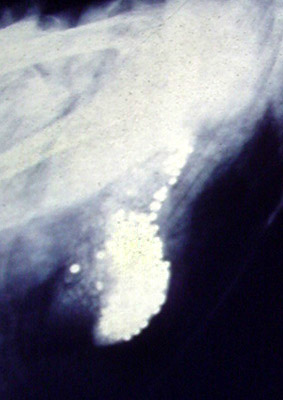Animal lead poisoning
Animal lead poisoning is a significant environmental and health issue affecting both wildlife and domestic animals. Lead, a toxic heavy metal, can be ingested or inhaled by animals, leading to a range of adverse health effects and often resulting in death. This article explores the causes, symptoms, diagnosis, treatment, and prevention of lead poisoning in animals.
Causes[edit | edit source]
Lead poisoning in animals can occur through several pathways. Common sources of lead exposure include:
- Ingestion of Paint Chips: Older buildings may contain lead-based paints. As these paints age and flake off, animals can ingest the chips.
- Contaminated Water: Industrial runoff and old lead pipes can contaminate water sources.
- Lead Shot and Fishing Sinkers: Birds, especially waterfowl, often ingest spent lead shot or fishing sinkers mistaking them for food or grit.
- Mining and Industrial Areas: Animals living near mining sites or industrial areas may be exposed to higher levels of lead in the environment.
- Lead-contaminated Soil: Animals grazing in areas with lead-contaminated soil can ingest lead through the plants they eat.
Symptoms[edit | edit source]
The symptoms of lead poisoning in animals vary depending on the level and duration of exposure. Common symptoms include:
- Gastrointestinal issues such as vomiting and diarrhea
- Neurological problems, including seizures, lack of coordination, and aggressive behavior
- Anemia
- Weight loss and loss of appetite
- Muscle weakness
- Fatigue
In severe cases, lead poisoning can lead to coma and death.
Diagnosis[edit | edit source]
Diagnosis of lead poisoning in animals involves a combination of clinical signs, history of potential exposure, and laboratory tests. Blood tests can measure the lead levels in an animal's system, confirming exposure and aiding in the diagnosis.
Treatment[edit | edit source]
Treatment for lead poisoning in animals focuses on removing the source of lead exposure, supportive care, and specific therapies to reduce lead levels in the body. Treatments may include:
- Chelation Therapy: Medications that bind to lead, allowing it to be excreted from the body.
- Supportive Care: Fluid therapy, nutritional support, and treatment of symptoms such as seizures.
- Environmental Management: Identifying and eliminating the source of lead exposure is crucial to prevent further poisoning.
Prevention[edit | edit source]
Preventing lead poisoning in animals involves reducing their exposure to lead. Measures include:
- Using lead-free paints and removing old lead-based paints from buildings and structures.
- Proper disposal of lead shot and fishing sinkers.
- Ensuring clean, uncontaminated water sources.
- Monitoring and managing industrial emissions and waste.
Conclusion[edit | edit source]
Animal lead poisoning is a preventable condition that poses a significant threat to the health and well-being of both domestic and wild animals. Awareness and proactive management of lead sources in the environment are critical to protecting animal populations from the harmful effects of lead exposure.
| Animal lead poisoning Resources | ||
|---|---|---|
|
| |
Translate to: East Asian
中文,
日本,
한국어,
South Asian
हिन्दी,
Urdu,
বাংলা,
తెలుగు,
தமிழ்,
ಕನ್ನಡ,
Southeast Asian
Indonesian,
Vietnamese,
Thai,
မြန်မာဘာသာ,
European
español,
Deutsch,
français,
русский,
português do Brasil,
Italian,
polski
Navigation: Wellness - Encyclopedia - Health topics - Disease Index - Drugs - World Directory - Gray's Anatomy - Keto diet - Recipes
Search WikiMD
Ad.Tired of being Overweight? Try W8MD's physician weight loss program.
Semaglutide (Ozempic / Wegovy and Tirzepatide (Mounjaro) available.
Advertise on WikiMD
WikiMD is not a substitute for professional medical advice. See full disclaimer.
Credits:Most images are courtesy of Wikimedia commons, and templates Wikipedia, licensed under CC BY SA or similar.
Contributors: Prab R. Tumpati, MD




